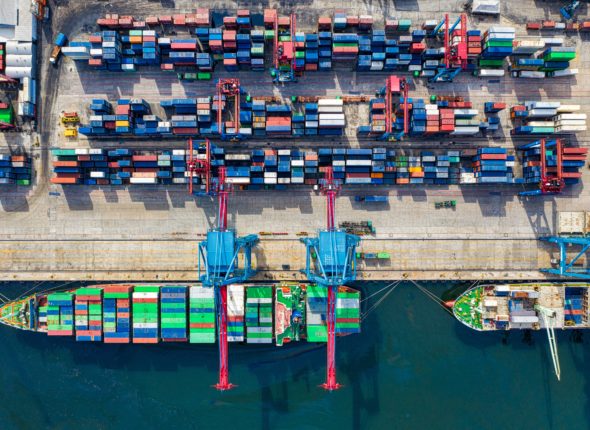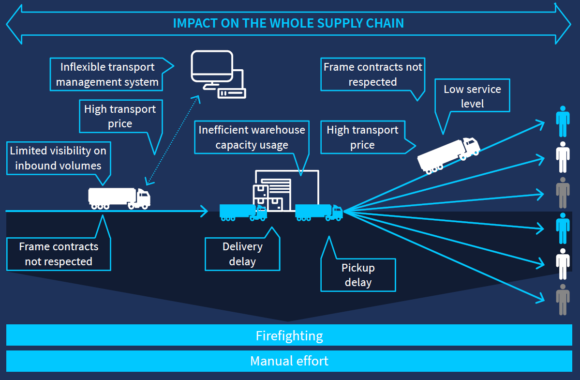In our last blog article, we introduced you to important and upcoming Transport Management technologies, released by Gartner in their latest Hype Cycle on Supply Chain Execution Technology.
Especially topics like web-based logistics portal(s) and transportation forecasting are important when it comes to Capacity Shortage. Even people outside the logistics community became aware of this problem because it was intensified and made visible by the COVID-19 pandemic with peaks leading to supply chain disruption.
Gartner’s Observations about future Transport Management
In our daily business with customers during this pandemic we see that digital transformation dictates developments towards speed and transparency. This requires adaptability and willingness to change. Let’s face it – many organizations are not there yet. Companies and leaders that downplay or underestimate the importance of digital transformation and refuse to embrace change have no chance in international competition. But once the fear of “uncertainty” and change is overcome and the C-level proactively seeks the opportunities that come with digital transformation the impact on efficiency, benefits, and long-term improvements for the business and the people involved are enormous.
One cluster in the overall transport management field which benefits from increasing connectivity is the management of capacity shortage: web-based, connected and with transportation forecasts as result of demand and production analytics. We are convinced that this will be of increasing relevance and strongly impact your IT landscape and daily operations. COVID-19 proves that our thoughts were right. It’s time to act now!
CAMELOT study confirms Gartner’s findings
To investigate reasons for capacity shortage, current use cases and mitigation strategies, we have recently conducted a study about this topic. Shippers as well as carriers were asked to provide their expert view on reasons and solutions for capacity shortages. Little did we know at that time that the issue would be more relevant than ever and that everyone of us would become aware of the impact of the capacity shortage caused by the COVID-19 pandemic, with the lack of raw materials for production and empty supermarket shelves.
It is fascinating to see, that all the mitigation strategies we collected from the group of participants, were widely used by many companies in logistics during the corona pandemic to deal with these extraordinary capacity shortages.
But what causes capacity shortage in general? It is a result of an imbalance between demand and supply of transport capacity and is even intensified by industry growth and higher shipment volume, and an outdated IT infrastructure.
CAMELOT Study highlights and conclusion
75% of LSPs and 62% of the shippers that took part in the study revealed that they faced capacity shortages in 2018 and 2019. Most of these occurred in road packed freight (LSP response), or are equally distributed among packed road freight, air freight and sea/ocean freight (shipper response).
To deal with these capacity shortages, companies are forced to shift additional workforce to securing transport capacity face higher transportation prices due to higher market demand and increased delivery transport lead time (shipper perspective). LSPs, on the other hand, must manage more pick-up delays with negative impact on warehouse operations and customer satisfaction, use of spot markets and contracted suppliers not delivering within the agreed-upon cost.
How did the participants handle capacity shortage? Here are the most important mitigation strategies:
- Higher prices were accepted
- Penalties were suspended
- Automation of processes and physical goods handling was enforced
- Shift to multi-source and delivery volume split approach
Based on our CAMELOT experience, we recommend implementing more solution elements to manage capacity shortages:
- Stronger focus on data analytics for enhanced and AI supported transport planning
- Interlink shippers and LSPs to share freight demands/ forecasts, capacity availability
- Enable advanced transport planning with the help of big data & machine learning
- Use of web-based Logistics Platforms to find the perfect price and time for the freight to be shipped
- Enhance the transport sourcing approach from a classical fix contract setup towards a more dynamic approach including penalties, higher spot market share and capacity pre-booking for stable transport demands
Situations of capacity shortages will increase in the future due to environmental changes, natural disasters, e.g. low water levels, or global pandemics and will affect the distribution of goods heavily.
The findings of our study are more current than ever. The study is available for free and can be downloaded here.
Let’s leave the firefighting behind and build a future-proof foundation for your transport management! We are looking forward to assessing the status quo of your transport management setup capabilities to cope with the next shortfall in transport capacity. Contact us for more information.
We would like to thank Ariane Brämer for his valuable contribution to this article.


